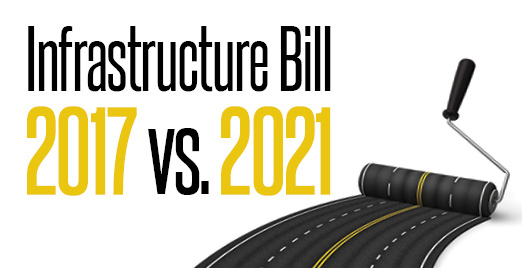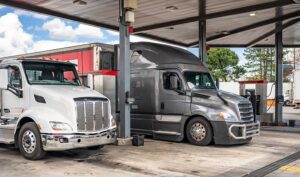Standing before a packed U.S. House of Representatives chamber on February 28, 2017, newly sworn-in President Donald J. Trump was delivering his first State of the Union address when he touched on a subject deeply ingrained in the minds of Americans — infrastructure.
“We’ve spent trillions and trillions of dollars overseas while our infrastructure at home has so badly crumbled,” said Trump, promising that America’s crumbling infrastructure “will be replaced with new roads, bridges, tunnels, airports, and railways gleaming across our very, very beautiful land.”
Almost one year later, the president unveiled the promised plan, a 53-page document that called for spending $1.5 trillion for repairing and upgrading the country’s infrastructure. Only $200 billion would come from federal coffers; the rest would come from state and local governments, which were expected to match any federal allocation by at least a four-to-one ratio.
On January 20, Trump will leave office with no plan having been approved, but the lack thereof rests not necessarily at his feet. A highly partisan Congress has spent the past four years batting transportation legislation back and forth with more intensity than a professional ping-pong competition.
Now, President-elect Joe Biden is outlining his own infrastructure plan that calls for a transformation investment of $1.3 trillion over 20 years to equip the American middle class to compete and win in the global economy, to move the U.S. to net-zero greenhouse gas emissions, and to ensure that cities, towns, and rural areas across our country share in that growth.
Biden said his infrastructure plan would be part of his efforts to “strengthen worker organizing, collective bargaining, and unions.”
Biden plans to jump-start the repair of highways, roads, and bridges, according to a document released in November outlining how he wants to invest in middle class competitiveness.
“Almost 20% of our roads are in poor condition, and there is a backlog of hundreds of billions of dollars of investment. Americans in cities lose more than 8.8 billion hours to traffic each year — an average 54 hours a year per commuter,” he said. “I propose to immediately spend $50 billion over the first year of my administration to kickstart the process of repairing our existing roads, highways, and bridges. In addition to sending these funds to states, some of the dollars will go directly to cities and towns that own and run most of our roads.”
Biden also said he will expedite permitting so that projects can break ground faster. Will Biden succeed where Trump did not?
That may be the proverbial trillion-dollar question, but the Truckload Carriers Association’s Vice President of Government Affairs David Heller feels the framework for a Biden infrastructure plan is within the Moving America Forward Act, which includes the tenants of the Investing in a New Vision for the Environment and Surface Transportation in America Act (better known as the INVEST in America Act).
This act eventually became part of the Moving Forward Act (MFA), which was passed by the House 233-188 last July.
The bill’s authors said MFA would:
- Deliver better roads and bridges faster with more than $300 billion of investment that prioritizes fixing what we already have, including tens of thousands of structurally deficient bridges;
- Invest more than $100 billion in transit to put more zero-emission buses on the road, add new routes, and provide more reliable service, resulting in better transit options and fewer single-occupant cars clogging highways; and
- Modernize infrastructure to reduce traffic congestion and address bottlenecks and make roads smarter and safer for all users.
“The House was very kind to provide us with the blueprint of what could be on the agenda in the Biden administration,” said Heller. “The bill, which is very centric, talks about many of the things that are important to the Democrats. A lot of the points in this could be part of a massive infrastructure bill.”
If one of the elements of the House-passed bill is included in any infrastructure legislation, trucking has some work to do, added Heller. “We are concerned about liability insurance premiums going up from $750,000 to $2 million.”
There’s also the issue of hair testing for substance abuse. Last year, the Department of Health and Human Services issued proposed guidelines that would allow hair testing only if it was coupled with another type of drug testing specimen.
Heller called the proposed guidelines “watered down.”
Then, of course, there’s the issue of money, which plagued Trump and will likely plague Biden.
When Trump took office, the balance of the Highway Trust Fund, which is the source of funding for most highway projects, was $47 billion.
At the end of FY2020 on September 30, 2020, the Congressional Budget Office said the balance was $14 billion. At the end of FY2021 on September 30, 2021, it is forecast to be insolvent.
Unless something is done to prop up the fund, the balance will be in the negative by $73 billion.
Biden’s plan calls for a stabilization of the Highway Trust Fund but offers no insight into how that might happen.
“A lot people project an infrastructure plan to be part of Biden’s first 100 days,” Heller pointed out. “So, if this is going to happen, we need to have a real discussion of how we actually pay for it.
An increase in the federal fuel tax (which hasn’t been raised since 1993) represents the most cost-effective way to raise money to support the Highway Trust Fund.”
While it may be the most cost-effective way, there is likely to be little support within Congress for a tax increase, especially in the House where members must face the voters again in two years and where the GOP made a 15-seat gain last cycle.
The fund has been hurt even more this year because the COVID-19 pandemic stopped a lot of driving, which means people didn’t go to the pump, Heller noted, so now the fund is in more dire straits than ever before.
So, when it comes to infrastructure, the country stands exactly where it did four years ago: No bill and no money.
Or as Yogi Berra, the Hall of Fame catcher for the New York Yankees, once said, “it’s like déjà vu all over again.”
Cliff Abbott is an experienced commercial vehicle driver and owner-operator who still holds a CDL in his home state of Alabama. In nearly 40 years in trucking, he’s been an instructor and trainer and has managed safety and recruiting operations for several carriers. Having never lost his love of the road, Cliff has written a book and hundreds of songs and has been writing for The Trucker for more than a decade.















